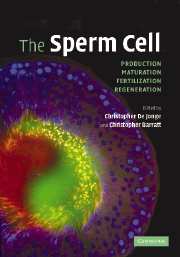Book contents
- Frontmatter
- Contents
- Preface
- List of contributors
- 1 Mammalian spermatogenesis and sperm structure: anatomical and compartmental analysis
- 2 Sperm chromatin stability and susceptibility to damage in relation to its structure
- 3 Genomic and proteomic approaches to defining sperm production and function
- 4 Sperm maturation in the human epididymis
- 5 Controls of sperm motility
- 6 Regulation of capacitation
- 7 Reactive oxygen species: friend or foe
- 8 Testing sperm manufacturing quality: the sperm–zona binding assay
- 9 Genetics: a basic science perspective
- 10 Sex chromosome abnormalities and male infertility: a clinical perspective
- 11 Epigenetic patterning in male germ cells: importance of DNA methylation to progeny outcome
- 12 The DAZ gene family and human germ cell development from embryonic stem cells
- Index
9 - Genetics: a basic science perspective
Published online by Cambridge University Press: 14 August 2009
- Frontmatter
- Contents
- Preface
- List of contributors
- 1 Mammalian spermatogenesis and sperm structure: anatomical and compartmental analysis
- 2 Sperm chromatin stability and susceptibility to damage in relation to its structure
- 3 Genomic and proteomic approaches to defining sperm production and function
- 4 Sperm maturation in the human epididymis
- 5 Controls of sperm motility
- 6 Regulation of capacitation
- 7 Reactive oxygen species: friend or foe
- 8 Testing sperm manufacturing quality: the sperm–zona binding assay
- 9 Genetics: a basic science perspective
- 10 Sex chromosome abnormalities and male infertility: a clinical perspective
- 11 Epigenetic patterning in male germ cells: importance of DNA methylation to progeny outcome
- 12 The DAZ gene family and human germ cell development from embryonic stem cells
- Index
Summary
Introduction
From mouse and Drosophila knock out experiments it has been deduced that the products of more than 3000 genes are involved in the genetic control regulating the expression of male (and female) fertility (Cooke and Saunders, 2002, Hackstein et al., 2000; Matzuk and Lamb, 2002). In human, the molecular identification of male fertility genes is hampered by the fact that human is not an experimental species. An infertile man is only recognised after the couple desiring for a child has asked for some therapeutic treatments in an infertility clinic.
Genetic lesions causing male infertility can be roughly grouped in three classes: (I) Chromosomal aneuploidies and rearrangements where batteries of genes on specific chromosomes have increased or decreased their expression dosage or have changed their normal nuclear territorium; (II) submicroscopic deletions (i.e. the genomic AZF deletions) where deletions or rearrangements of multiple genes – mapped in a molecular neighbourhood – have lost or altered their normal expression pattern and (III) single gene defects where the expression of a single gene is changed or lost causing then male infertility (e.g. the CFTR gene). This chapter offers a basic science perspective to the molecular genetic principles causing male infertility in the three different genetic-abnormality groups. Thereby one aim is to point to the practical prerequisites which will be needed for their proper analysis in the infertility clinic reducing time and costs and increasing the patient's success rate for conceiving a child without an inherited genetic abnormality.
- Type
- Chapter
- Information
- The Sperm CellProduction, Maturation, Fertilization, Regeneration, pp. 217 - 260Publisher: Cambridge University PressPrint publication year: 2006
- 1
- Cited by



